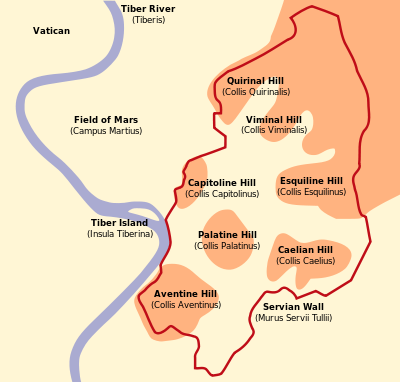Seven hills of Rome

Schematic map of Rome showing the seven hills
The seven hills of Rome (Italian: Sette colli di Roma [ˈsɛtte ˈkɔlli di ˈroːma], Latin: Septem colles/montes Romae) east of the river Tiber form the geographical heart of Rome, within the walls of the city.
The seven hills are:[1]
Aventine Hill (Latin, Aventinus; Italian, Aventino)
Caelian Hill (Cælius, Celio)
Capitoline Hill (Capitolinus, Campidoglio)
Esquiline Hill (Esquilinus, Esquilino)
Palatine Hill (Palatinus, Palatino)
Quirinal Hill (Quirinalis, Quirinale)
Viminal Hill (Viminalis, Viminale)
The Vatican Hill (Latin Collis Vaticanus) lying northwest of the Tiber, the Pincian Hill (Latin Mons Pincius), lying to the north, and the Janiculum Hill (Latin Ianiculum), lying to the west, are not counted among the traditional Seven Hills.
Contents
1 History
1.1 Other cities with seven hills
2 In the New Testament
3 See also
4 References
History
Tradition holds that Romulus and Remus founded the original city on the Palatine Hill on April 21st, 753 BC, and that the seven hills were first occupied by small settlements that were not grouped nor recognized as a city called Rome. The seven hills' denizens began to interact, which began to bond the groups. The city of Rome, thus, came into being as these separate settlements acted as a group, draining the marshy valleys between them and turning them into markets (fora in Latin). Later, in the early 4th century BC, the Servian Walls were constructed to protect the seven hills.[2]
In modern Rome, five of the seven hills, the Aventine, Caelian, Esquiline, Quirinal, and Viminal Hills, are now the sites of monuments, buildings, and parks. The Capitoline Hill is the location of Rome's city hall, and the Palatine Hill is part of the main archaeological area.
Other cities with seven hills
Constantinople, Lisbon and the Massachusetts cities of Worcester and Newton (among many others) are also said to have been built on seven hills, following the example of Rome.
In the New Testament
In the Book of Revelation, the Whore of Babylon sits on "seven mountains",[3] typically understood as the seven hills of Rome.[4][5][6][7][8]
See also
- Other Roman hills
- Monte Mario
- Oppian Hill (Oppio)
- Velian Hill (Velia)
- Pincian Hill
Monte Testaccio, an artificial hill composed primarily of broken amphorae
- Janiculum Hill (Gianicolo)
- General
- Seven hills
References
^ Heiken, Grant; Funiciello, Renato; de Rita, Donatella (Oct 24, 2013). "Chapter 11: Field Trips in and Around Rome". The Seven Hills of Rome: A Geological Tour of the Eternal City. books.google.com. Princeton University Press. p. 174. ISBN 9780691130385. Retrieved 14 February 2019..mw-parser-output cite.citation{font-style:inherit}.mw-parser-output .citation q{quotes:"""""""'""'"}.mw-parser-output .citation .cs1-lock-free a{background:url("//upload.wikimedia.org/wikipedia/commons/thumb/6/65/Lock-green.svg/9px-Lock-green.svg.png")no-repeat;background-position:right .1em center}.mw-parser-output .citation .cs1-lock-limited a,.mw-parser-output .citation .cs1-lock-registration a{background:url("//upload.wikimedia.org/wikipedia/commons/thumb/d/d6/Lock-gray-alt-2.svg/9px-Lock-gray-alt-2.svg.png")no-repeat;background-position:right .1em center}.mw-parser-output .citation .cs1-lock-subscription a{background:url("//upload.wikimedia.org/wikipedia/commons/thumb/a/aa/Lock-red-alt-2.svg/9px-Lock-red-alt-2.svg.png")no-repeat;background-position:right .1em center}.mw-parser-output .cs1-subscription,.mw-parser-output .cs1-registration{color:#555}.mw-parser-output .cs1-subscription span,.mw-parser-output .cs1-registration span{border-bottom:1px dotted;cursor:help}.mw-parser-output .cs1-ws-icon a{background:url("//upload.wikimedia.org/wikipedia/commons/thumb/4/4c/Wikisource-logo.svg/12px-Wikisource-logo.svg.png")no-repeat;background-position:right .1em center}.mw-parser-output code.cs1-code{color:inherit;background:inherit;border:inherit;padding:inherit}.mw-parser-output .cs1-hidden-error{display:none;font-size:100%}.mw-parser-output .cs1-visible-error{font-size:100%}.mw-parser-output .cs1-maint{display:none;color:#33aa33;margin-left:0.3em}.mw-parser-output .cs1-subscription,.mw-parser-output .cs1-registration,.mw-parser-output .cs1-format{font-size:95%}.mw-parser-output .cs1-kern-left,.mw-parser-output .cs1-kern-wl-left{padding-left:0.2em}.mw-parser-output .cs1-kern-right,.mw-parser-output .cs1-kern-wl-right{padding-right:0.2em}
^ "The Seven Hills of Rome", Italy Magazine italymagazine.com, accessed 14 February 2019
^ (the King James Version Bible—the New International Version Bible uses the words "seven hills")
^ Wall, R. W. (1991). New International Biblical Commentary: Revelation (207). Peabody, MA: Hendrickson Publishers.
^ Bratcher, R. G., & Hatton, H. (1993). A Handbook on the Revelation to John. UBS handbook series; Helps for translators (248). New York: United Bible Societies.
^ Davis, C. A. (2000). Revelation. The College Press NIV commentary (322). Joplin, Mo.: College Press Pub.
^ Mounce, R. H. (1997). "The Book of Revelation." The New International Commentary on the New Testament (315). Grand Rapids, MI: Wm. B. Eerdmans Publishing Co.
^ Beckwith, Isbon T. The Apocalypse of John. New York: MacMillan, 1919; reprinted, Eugene: Wipf and Stock Publishers, 2001.